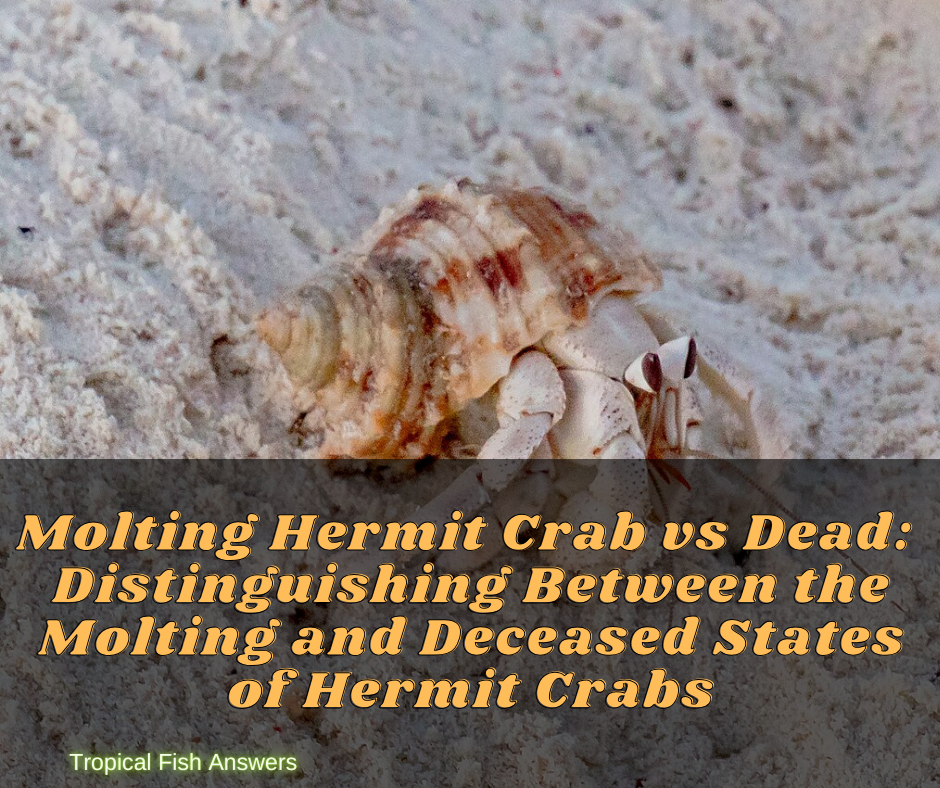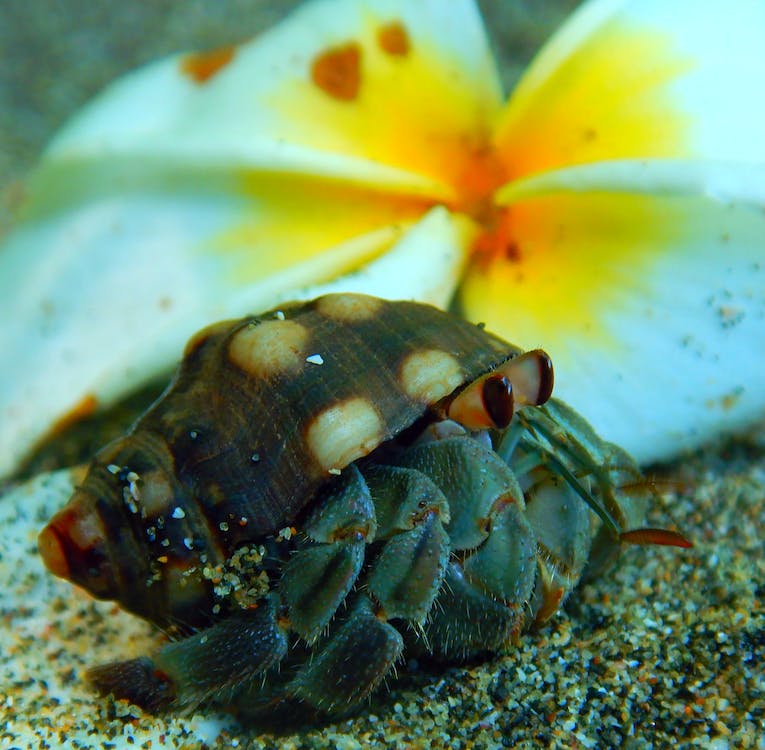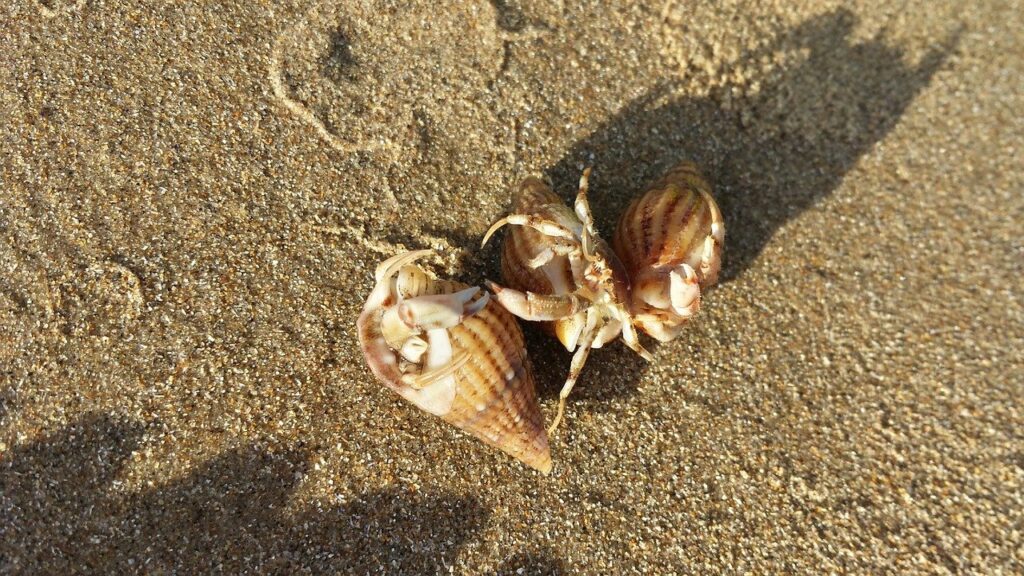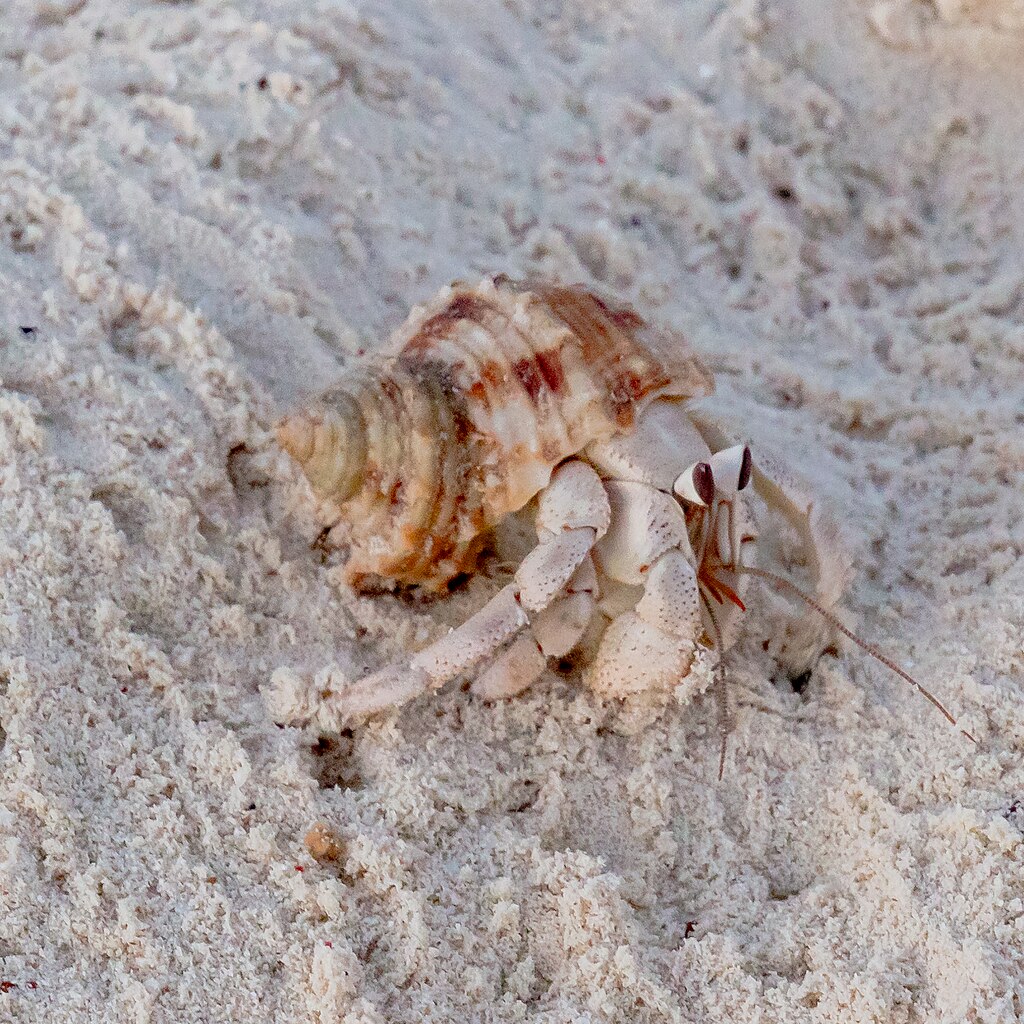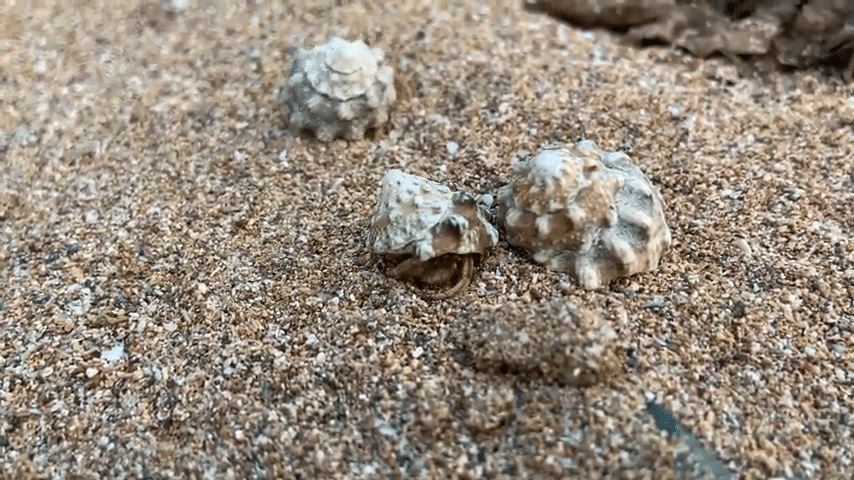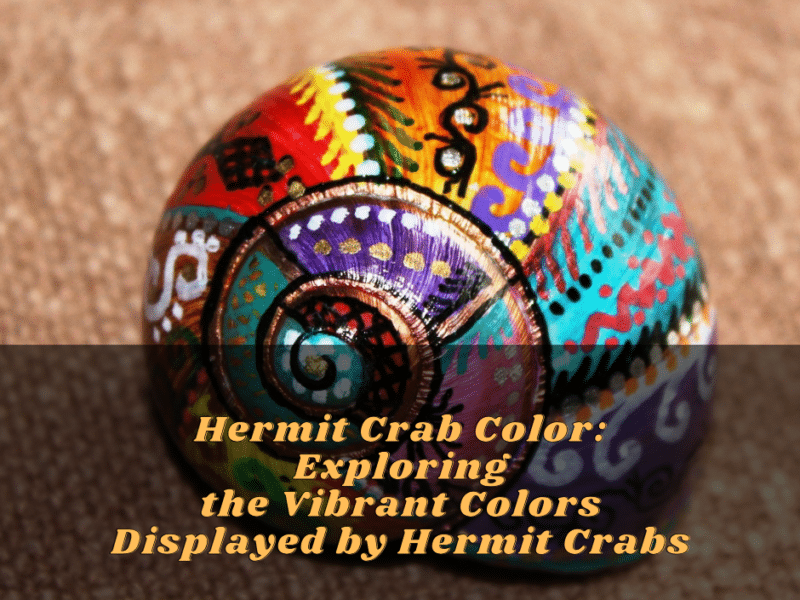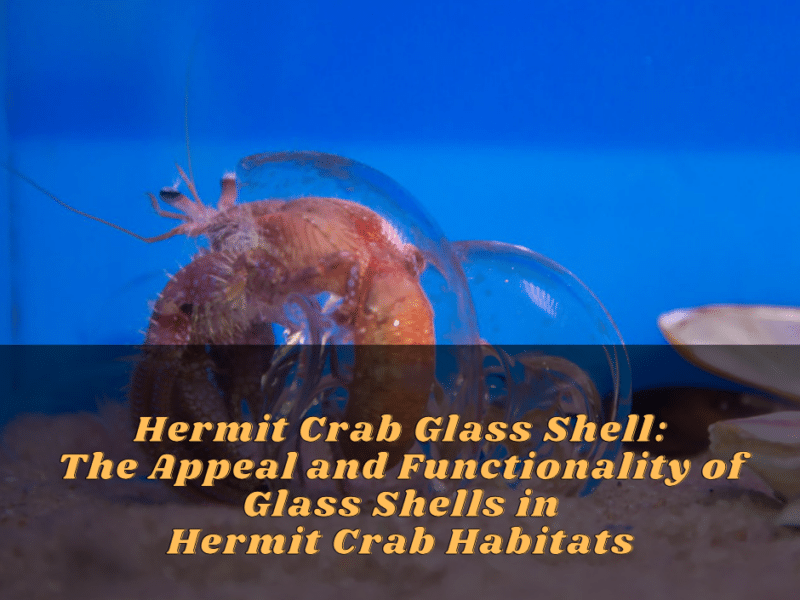Introduction
Hermit crabs are fascinating creatures known for their unique habit of living inside discarded shells. They are commonly kept as pets due to their low maintenance and interesting behavior. However, when a hermit crab appears motionless or seemingly lifeless, it can be difficult to determine whether it is undergoing molting or if it has passed away. Distinguishing between the molting and deceased states of hermit crabs is crucial to ensure their well-being and provide appropriate care. In this article, we will explore the different states of hermit crabs, specifically molting and deceased, and discuss the importance of accurately identifying their condition.
Molting Hermit Crab vs Dead – Exploring The Different States Of Hermit Crabs
Hermit crabs go through a cycle of growth and renewal, which involves shedding their exoskeleton in a process called molting. During molting, they temporarily retreat into their shell and remain hidden. This is a natural and vital process for their development and growth. The frequency of molting varies depending on factors such as age, species, and environmental conditions. Younger hermit crabs tend to molt more frequently than older ones.
On the other hand, the deceased state occurs when a hermit crab passes away. Death in hermit crabs can be caused by various factors, including old age, stress, disease, or inadequate care. It is important to note that hermit crabs have a relatively short lifespan, typically ranging from 3 to 30 years depending on the species. Understanding the signs and differences between molting and deceased states is crucial for providing appropriate care and taking necessary action.
Understanding The Importance Of Distinguishing Between The Two States
Accurately identifying whether a hermit crab is molting or deceased is essential for several reasons. Here are a few key points:
- Caring for Molting Hermit Crabs: When a hermit crab is molting, it is in a vulnerable state. During this period, they may be softer and more sensitive due to the shedding of their exoskeleton. It is vital to provide a stress-free, quiet, and controlled environment to allow for a successful molt. Disturbing a molting hermit crab can lead to injuries or even death. Therefore, recognizing the signs of molting and giving them space is crucial for their well-being.
- Preventing Accidental Discarding: Hermit crabs often change shells during molting. If a molting hermit crab is mistakenly identified as deceased and its shell is discarded, it could cause significant harm or death to the hermit crab. By accurately distinguishing between the molting and deceased states, the risk of accidentally discarding a live hermit crab is minimized.
- Identifying Health Issues: Recognizing the signs of death in hermit crabs is essential for identifying potential health issues within their habitat or care routine. If multiple hermit crabs in the same enclosure are experiencing premature deaths, it could indicate underlying problems such as improper temperature, humidity levels, or inadequate nutrition. Proper identification of a deceased hermit crab allows for immediate action to address any potential issues and safeguard the health of the remaining crabs.
By understanding the importance of accurately distinguishing between molting and deceased states, hermit crab enthusiasts can provide optimal conditions for molting, prevent accidental harm to molting crabs, and take necessary measures to ensure a healthy environment for their pets.
Identifying Molting Hermit Crabs
When it comes to hermit crabs, distinguishing between molting and deceased states is crucial for their well-being. Here are some key points to help you identify molting hermit crabs:
Observing The Hunched Back Position During The Molting Process
During the molting process, hermit crabs assume a distinct hunched back position. This is because they need to shed their old exoskeleton and form a new one. The hunched back position allows room for the molting process to take place. It is important to note that the molting process can take several weeks, so it is essential to be patient and provide a quiet and stress-free environment for the molting hermit crab.
Examining The Clean Shell Interior And Hinging At The Eyes Of A Molted Shell
When a hermit crab successfully undergoes molting, it leaves behind its old exoskeleton inside the shell. You can examine the interior of the shell to determine if a hermit crab has recently molted. A molted shell will have a clean interior, devoid of any exoskeleton remains. Additionally, you may notice a hinging at the eyes of the shell, indicating that the hermit crab has shed its old exoskeleton.
It is important to remember that identifying a molting hermit crab can be challenging, as they prefer to remain hidden during this vulnerable stage. If you suspect that your hermit crab is molting, it is best to avoid disturbing it and provide a calm and controlled environment to facilitate a successful molt.
However, if you are unsure whether your hermit crab is molting or deceased, there are a few signs that can help you differentiate between the two states:
- Smell: A deceased hermit crab may emit a foul odor, while a molting hermit crab should not have any odor.
- Motionlessness: A deceased hermit crab will be completely motionless for an extended period, whereas a molting hermit crab may show slight movements or twitching.
- Exoskeleton: When a hermit crab passes away, its exoskeleton will remain intact within the shell. In contrast, a molting hermit crab will shed its exoskeleton, leaving it inside the shell.
If you determine that a hermit crab has indeed passed away, it is important to remove the deceased crab and take appropriate measures to prevent any further harm to the remaining hermit crabs. It is also advisable to monitor the overall health and conditions of your hermit crab habitat to ensure the well-being of the other crabs.
In conclusion, correctly identifying whether a hermit crab is molting or deceased is essential for their care and well-being. By observing the hunched back position and examining the clean shell interior and hinging at the eyes of a molted shell, you can determine if a hermit crab is in the molting process. If unsure, it is best to err on the side of caution and provide a calm and controlled environment for your hermit crab.
Differentiating Dead Hermit Crabs
One of the challenges faced by hermit crab owners is distinguishing between molting and deceased states. It is crucial to accurately identify whether a hermit crab is molting or dead to ensure their well-being. Here are some key points to help you differentiate between the two states:
Noticing Goo Of Various Colors In The Abdomen Of A Dead Crab
When a hermit crab passes away, there are several signs that can indicate its demise. One of these signs is the appearance of goo in the abdomen. The color of the goo can vary, ranging from greenish-yellow to dark brown or black. This goo is a result of decomposition and can have a strong odor. If you notice this goo in your hermit crab’s abdomen, it is a clear indication that the crab has passed away.
Recognizing Patterns Of Shell Damage Characteristic Of Certain Predators
Another way to differentiate between a molting hermit crab and a deceased one is to examine the shell for patterns of damage. Certain predators, such as crabs or birds, may attack hermit crabs and leave distinctive marks on their shells. These marks can include scratches, punctures, or chunks missing from the shell. If you observe such damage on your hermit crab’s shell, it is likely that the crab has been attacked and is deceased.
It is important to remember that identifying a dead hermit crab can be challenging, as they can often hide and be motionless. If you suspect that your hermit crab may be deceased, there are a few additional signs to consider:
- Smell: A deceased hermit crab may emit a foul odor. This odor is distinct and can be quite strong. If you notice an unpleasant smell coming from your hermit crab habitat, it is likely that a crab has passed away.
- Motionlessness: A deceased hermit crab will be completely motionless for an extended period. Unlike molting crabs, which may show slight movements or twitching, a dead crab will remain still and show no signs of life.
- Exoskeleton: When a hermit crab dies, its exoskeleton will remain intact within the shell. In contrast, a molting hermit crab will shed its exoskeleton, leaving it inside the shell. If you observe a complete exoskeleton within the shell, it is an indication that the crab has passed away.
If you determine that a hermit crab has indeed passed away, it is important to remove the deceased crab promptly. Leaving a dead crab in the habitat can lead to health issues for the remaining crabs. Additionally, it is advisable to monitor the overall health and conditions of your hermit crab habitat to ensure the well-being of the other crabs.
In conclusion, correctly differentiating between molting and deceased hermit crabs is crucial for their care and well-being. By observing signs such as the presence of goo in the abdomen and patterns of shell damage, you can determine if a hermit crab is deceased. Additionally, factors such as smell, motionlessness, and the presence of a complete exoskeleton can further confirm the crab’s passing. If unsure, it is always best to err on the side of caution and seek advice from experts or experienced hermit crab owners. By providing a calm and controlled environment for your hermit crab, you can ensure their health and happiness.
Additional Factors To Consider
The Stillness And Appearance Of Being Dead During The Molting Process
During the molting process, hermit crabs may appear motionless and exhibit characteristics that can be mistaken for death. This can be a source of concern for hermit crab owners who are unsure whether their crab is molting or deceased. Here are some key factors to consider when differentiating between the two states:
- Lack of movement: Molting hermit crabs will often remain still for extended periods while undergoing the molting process. They may appear lifeless and show no signs of activity. It is important to carefully observe their behavior and look for subtle signs of life, such as slight movements or twitching. Dead hermit crabs, on the other hand, will remain completely motionless for an extended period.
- Change in appearance: Molting hermit crabs will go through visible changes in appearance during the molting process. Their exoskeleton will become softer and lighter in color, and their eyes may appear cloudy or opaque. In contrast, dead hermit crabs will not undergo any changes in appearance.
- Burrowing behavior: Molting hermit crabs will often dig and bury themselves in the substrate to create a safe and secluded space for the molting process. They may also seal themselves inside their shells using a mucus-like substance. Dead hermit crabs do not exhibit this burrowing behavior.
Analyzing Color Differences Between Dead Crabs And Molted Shells
Another factor to consider when differentiating between molting hermit crabs and deceased ones is the color difference between a dead crab and a molted shell. Here are some key points to help you analyze the color differences:
- Dead crabs: When a hermit crab passes away, its body will undergo decomposition, leading to a change in color. The color of a dead hermit crab can vary from a greenish-yellow hue to a dark brown or black color. The appearance of goo in the abdomen is a clear indication of the crab’s demise. This goo is a result of decomposition and can have a strong odor.
- Molted shells: When a hermit crab molts, it sheds its exoskeleton, leaving behind an empty shell. The molted shell will have a lighter color compared to a dead crab. The exoskeleton will be intact and can be easily distinguished from the soft body of a live crab.
It is important to note that accurately differentiating between molting hermit crabs and deceased ones can be challenging. If you suspect that your hermit crab may be deceased, it is advised to observe additional signs, such as a foul odor, complete motionlessness, and the presence of a complete exoskeleton within the shell. These factors can help confirm the crab’s passing.
If you are uncertain about the status of your hermit crab, it is always best to seek advice from experts or experienced hermit crab owners. They can provide guidance based on their knowledge and experience. Creating a calm and controlled environment for your hermit crab, ensuring proper care and monitoring their overall health and well-being, is essential for their happiness and longevity.
In conclusion, accurately differentiating between molting hermit crabs and deceased ones is crucial for the care and well-being of these fascinating crustaceans. By observing signs such as the stillness and appearance of being dead during the molting process, as well as analyzing color differences between dead crabs and molted shells, hermit crab owners can make informed judgments. When in doubt, seeking advice from experts or experienced hermit crab owners is always recommended. With proper care and attention, you can ensure the health and happiness of your hermit crab.
Conclusion
Accurately differentiating between molting hermit crabs and deceased ones is crucial for the care and well-being of these fascinating crustaceans. By observing signs such as the stillness and appearance of being dead during the molting process, as well as analyzing color differences between dead crabs and molted shells, hermit crab owners can make informed judgments. When in doubt, seeking advice from experts or experienced hermit crab owners is always recommended. With proper care and attention, you can ensure the health and happiness of your hermit crab.
The Significance Of Distinguishing Between Molting Hermit Crabs And The Deceased Ones
Understanding the difference between molting and deceased hermit crabs is essential for providing appropriate care and maintaining their overall well-being. Mistaking a molting crab for a deceased one can lead to unnecessary interventions that can harm or disrupt the molting process. On the other hand, failing to recognize a deceased crab may result in unaddressed health issues within the tank, potentially endangering other inhabitants. Accurately identifying the state of a hermit crab can help ensure a calm and controlled environment, suitable living conditions, and timely interventions when necessary.
Tips For Accurately Identifying The State Of A Hermit Crab
To accurately distinguish between a molting hermit crab and a deceased one, here are some tips to consider:
- Observe behavior: Molting hermit crabs will exhibit stillness and may appear motionless for extended periods. Look for subtle signs of life, such as slight movements or twitching, to confirm that the crab is alive. Dead hermit crabs will remain completely motionless for an extended period.
- Examine appearance: Molting hermit crabs will go through visible changes in appearance during the molting process. Their exoskeleton will become softer and lighter in color, and their eyes may appear cloudy or opaque. In contrast, dead hermit crabs will not undergo any changes in appearance.
- Monitor burrowing behavior: Molting hermit crabs will often dig and bury themselves in the substrate to create a safe and secluded space for the molting process. They may also seal themselves inside their shells using a mucus-like substance. Dead hermit crabs do not exhibit this burrowing behavior.
- Consider odor: If you suspect that a hermit crab may be deceased, observe for any foul odor. The presence of a strong smell, along with complete motionlessness and the presence of a complete exoskeleton within the shell, can help confirm the crab’s passing.
Remember, accurately identifying the state of a hermit crab can be challenging, and it is essential to take additional signs into account. If you remain uncertain, it is always best to seek advice from experts or experienced hermit crab owners who can provide guidance based on their knowledge and experience.
Frequently Asked Questions
Q: Can molting hermit crabs move during the molting process?
A: Yes, molting hermit crabs can show slight movements or twitching even though they appear still or motionless most of the time. These movements are signs that the crab is alive and undergoing the molting process.
Q: How long does the molting process typically last for hermit crabs?
A: The duration of the molting process can vary among individual hermit crabs. It can take anywhere from a few weeks to several months for a hermit crab to complete the molting process.
Q: Can hermit crabs die during the molting process?
A: Unfortunately, hermit crabs can die during the molting process. Molting is a vulnerable stage for them, and various factors such as stress, inadequate conditions, or health issues can increase the risk of mortality.
Q: Are there any precautions to take when handling a molting hermit crab?
A: It is crucial to avoid disturbing or handling a molting hermit crab as much as possible. Physical contact or excessive disruptions can disrupt the molting process and potentially harm the crab.
Q: How can I create a conducive environment for molting hermit crabs?
A: Providing a suitable substrate depth, maintaining proper humidity levels, and ensuring an appropriate temperature range are essential for creating a conducive environment for molting hermit crabs. Additionally, offering hiding spaces and minimizing disturbances can help support their molting process.
Remember, providing a calm and controlled environment for your hermit crab, ensuring proper care, and monitoring their overall health and well-being are essential for their happiness and longevity.
FAQ about Molting Hermit Crab vs Dead: Distinguishing Between the Molting and Deceased States of Hermit Crabs
Q: How can I tell if my hermit crab is molting or dead?
A: It can be challenging to determine whether a hermit crab is molting or dead. However, as a general rule, it’s safer to assume molting before death unless you have evidence to the contrary. Pay attention to the following signs to help you differentiate between the two states.
Q: What should I look out for when checking for signs of life in my hermit crab?
A: Firstly, sniff around for a fishy rotten smell. If you detect this odor, it is a strong indication of a dead hermit crab. Secondly, observe the crab’s body for any small twitches, which may suggest that it is still alive, especially during the molting process. Additionally, if your hermit crab has buried itself in the sand and you haven’t seen any movement for a while, it’s likely either molting or deceased.
Q: Are there any other signs I should be aware of when determining if my hermit crab is dead or molting?
A: Yes, another way to test for signs of life is to move the crab to a different location and observe if it changes position after a few hours. If it remains immobile, it might be dead. Additionally, if you notice a fishy rotten smell around the crab, it is indicative of death.
Q: Can hermit crabs bury themselves when they are molting?
A: Yes, it is perfectly natural for hermit crabs to bury themselves, which can make it even more challenging to determine their state. They may bury themselves during both molting or when they feel threatened or scared.
Q: What can I do if I suspect my hermit crab is molting or deceased?
A: If you suspect your hermit crab is molting, provide it with a quiet and undisturbed environment. Avoid handling or disturbing it during the molting process. However, if you believe it may be deceased, it’s essential to remove the crab from its tank to prevent any potential health risks to other crabs.
Remember, it’s crucial to observe and assess multiple signs before coming to a conclusion about your hermit crab’s state. If you’re unsure, it’s always best to consult with a veterinarian or an experienced hermit crab owner for further guidance.
